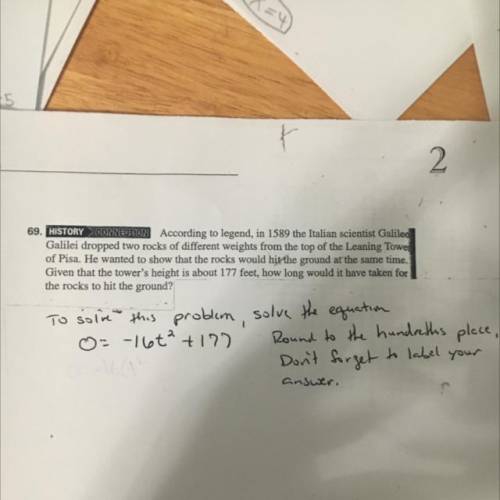
Mathematics, 25.11.2021 15:50 bthakkar25
According to legend, in 1589 the Italian scientist Galileo
Galilei dropped two rocks of different weights from the top of the Leaning Tower
of Pisa. He wanted to show that the rocks would hit the ground at the same time.
Given that the tower's height is about 177 feet, how long would it have taken for
the rocks to hit the ground?
1
To solve this problem solve the equation
O= 16t² + 177 Round to the hundrettes place,
Don't forget
to label your
answer


Answers: 1
Another question on Mathematics

Mathematics, 21.06.2019 17:00
Use the frequency distribution, which shows the number of american voters (in millions) according to age, to find the probability that a voter chosen at random is in the 18 to 20 years old age range. ages frequency 18 to 20 5.9 21 to 24 7.7 25 to 34 20.4 35 to 44 25.1 45 to 64 54.4 65 and over 27.7 the probability that a voter chosen at random is in the 18 to 20 years old age range is nothing. (round to three decimal places as needed.)
Answers: 1

Mathematics, 21.06.2019 20:00
Sarah took the advertising department from her company on a round trip to meet with a potential client. including sarah a total of 11 people took the trip. she was able to purchase coach tickets for $280 and first class tickets for $1280. she used her total budget for airfare for the trip, which was $6080. how many first class tickets did she buy? how many coach tickets did she buy?
Answers: 1

Mathematics, 21.06.2019 20:00
Use the elimination method to solve the systems of equations.choose the correct ordered pair. 7x+4y=39
Answers: 1

Mathematics, 21.06.2019 21:40
Write the contrapositive of the conditional statement. determine whether the contrapositive is true or false. if it is false, find a counterexample. a converse statement is formed by exchanging the hypothesis and conclusion of the conditional. a) a non-converse statement is not formed by exchanging the hypothesis and conclusion of the conditional. true b) a statement not formed by exchanging the hypothesis and conclusion of the conditional is a converse statement. false; an inverse statement is not formed by exchanging the hypothesis and conclusion of the conditional. c) a non-converse statement is formed by exchanging the hypothesis and conclusion of the conditional. false; an inverse statement is formed by negating both the hypothesis and conclusion of the conditional. d) a statement not formed by exchanging the hypothesis and conclusion of the conditional is not a converse statement. true
Answers: 1
You know the right answer?
According to legend, in 1589 the Italian scientist Galileo
Galilei dropped two rocks of different...
Questions







Mathematics, 22.09.2019 15:30

Geography, 22.09.2019 15:30


Health, 22.09.2019 15:30

History, 22.09.2019 15:30



Mathematics, 22.09.2019 15:30


English, 22.09.2019 15:30

English, 22.09.2019 15:30

Social Studies, 22.09.2019 15:30





